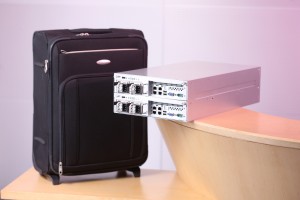Intel showcases technology with "Cloud-In-A-Box"

Billing it as "the world's smallest datacenter" Intel's cloud technology demonstrator is basically two 1U servers in a package that fits into a common rolling suitcase. Designed to show that Intel is already powering the cloud with its Xeon processors, the technology demonstration is also meant to highlight Intel's other efforts to bring their Cloud 2015 vision to reality.
The servers are used to demonstrate a variety of Intel technologies, starting with the latest advances in the Xeon processor family, including support for hardware-based encryption and Intel's Trusted Execution Technology, which focuses on security at the hypervisor level and below. Since we are talking about demonstrating cloud technologies, Intel's hardware Virtualization Technology is also heavily featured.
Multiple boxes in the demonstrator mean that they can demonstrate the Intelligent Power Node Manager which allows administrators to set power budgets for managed devices. Beyond the hardware level, Intel's single-sign on software technologies, Expressway Access 360 and the Expressway Gateway Service are part of the basic demonstration capabilities.
This is clearly designed as a portable technology demonstration tool and it doesn't seem that Intel is looking to actively sell this device to customers at this time. But there is definitely a market for this cloud-in-a-box, or at least a commercial version with additional bells and whistles for organizations that need to be able to deploy secure services in remote locations, vendors looking to do on-site demonstrations of their products for the private cloud, and even for IT departments looking to develop operational practices in a test network, rather than a live production environment.
The hardware package also fits well into the concept of a distributed computing environment with micro-datacenters scattered throughout a geographically dispersed area, that are all components of a larger, virtual, computing effort. It's an interesting little device, and may have more potential than just as a technology demonstration.
